Cushion plants, essential for biodiversity in the high mountains
Abstract
Cushion plants are squat life forms with padded shapes that have evolved to survive the harsh environmental conditions of high mountains such as: low temperatures, high winds, and poor and unstable soils. Cushion plants accumulate organic matter under their canopies, maintain increased humidity and help avoid sudden temperature changes, promoting soil formation as well as the germination, establishment and growth of other plants that could not successfully establish on bare soil. Therefore, it is of great importance to know and understand their functioning and role in mountain ecosystems, as well as the vulnerability of cushion plants to current climate change.
Downloads
References
Almeida-Leñero, J.L., Escamilla, M., Giménez, J., González, A. y Cleef, A.M. 2016. Vegetación alpina de los volcanes Popocatépetl, Iztaccíhuatl y Nevado de Toluca. UNAM. 266-286 pp.
Aubert, S., Boucher, F., Lavergne, S., Renaud, J. y Choler, P. 2014. A revised worlwide catalogue of cushion plants 100 years after Hauri and Schröter. Alpa Botany, 124(1): 59-70.
Badano, E.I., Molina-Montenegro, Ma., Quiroz, C. y Cavieres, L.A. 2002. Efecto de Oreopulus Glacialis (Rubiáceae) sobre la riqueza y diversidad de especies de plantas en una comunidad Alto-Andina. Revista Chilena de Historia Natural, 75(4): 757-765.
Cavieres, L.A., Badano, E.I., Sierra-Almeida, A. y Molina-Montenegro, M.A. 2007. Microclimatic modifications of cushion plants and their consequences for seedling survival of native and non-native herbaceous species in the high Andes of Central Chile. Arctic, Antarctic and Alpine Research, 39(2): 229-236.
Cavieres, L.A., Peñaloza, A., Papic, C. y Tambutti M. 1998. Efecto nodriza del cojín Laretia acaulis (Umbelliferae) en la zona alto-andina de Chile central. Revista Chilena de Historia Natural, 71: 337-347.
Ciccazzo, S., Esposito, A., Rolli, E., Zerbe, S., Daffonchio, D. y Brusetti, L. 2014. Different Pioneer plant species select specific rhizosphere bacterial communities in a high mountain environment. SpringerPlus, 3(391): 1-10.
Diario Oficial de la Federación. 2015. Proyecto de Modificación del Anexo Normativo III, Lista de especies en riesgo de la Norma Oficial Mexicana 059-SEMARNAT-2010, Protección ambiental de Especies Nativas de México de flora y fauna silvestres. Categorías de riesgo y especificaciones para su inclusión, exclusión o cambio-Lista de especies en riesgo, publicada el 30 de diciembre de 2010. Secretaría de Gobernación, México. Recuperado de http://dof.gob.mx/nota_detalle.php.
Molina-Montegro, M.A., Torres, C., Parra, M.J. y Cavieres, L.A. 2000. Asociación de especies al cojín Azorella Trifurcata (Apiaceae) en la Zona Andina de Chile Central (31°S). Gayana Botánica, 57(2): 161-168.
Reháková, K.A., Chronáková, V., Krištúfek, B., Kuchtová, K., Capková, J., Scharfen, Capek, P. y Doležal, J. 2015. Bacterial community of cushion plant Thylacospermum ceaspitosum on elevational gradient in the Himalayan cold desert. Frontiers in Microbiology, 6(304): 1-16.
Sklenár, P. 2009. Presence of cushion plants increases community diversity in the high equatorial Andes. Revista Flora-Morphology distribution functional ecology of plants, 204(4): 270-277.











